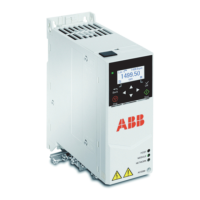62 Program features
The main difference between traditional control and vector control is that torque
control operates at the same time level as the power switch control. There is no
separate voltage and frequency controlled PWM modulator; the output stage
switching is wholly based on the electromagnetic state of the motor.
The best motor control accuracy is achieved by activating a separate motor
identification run (ID run).
See also section Speed control performance figures on page 68.
Parameters
Parameters: 99.04 Motor control mode and 99.13 ID run requested.
Reference ramping
Acceleration and deceleration ramping times can be set individually for speed, torque
and frequency reference.
With a speed or frequency reference, the ramps are defined as the time it takes for
the drive to accelerate or decelerate between zero speed or frequency and the value
defined by parameter 46.01 Speed scaling or 46.02 Frequency scaling. The user can
switch between two preset ramp sets using a binary source such as a digital input.
For speed reference, also the shape of the ramp can be controlled.
With a torque reference, the ramps are defined as the time it takes for the reference
to change between zero and nominal motor torque (01.30 Nominal torque scale).
Variable slope
Variable slope controls the slope of the speed ramp during a reference change. With
this feature a constantly variable ramp can be used.
Variable slope is only supported in remote control.
Parameters
Parameters: 23.28 Variable slope enable and 23.29 Variable slope rate.
Special acceleration/deceleration ramps
The acceleration/deceleration times for the jogging function can be defined
separately; see section Jogging on page 65.
The change rate of the motor potentiometer function (page 99) is adjustable. The
same rate applies in both directions.
A deceleration ramp can be defined for emergency stop (“Off3” mode).

